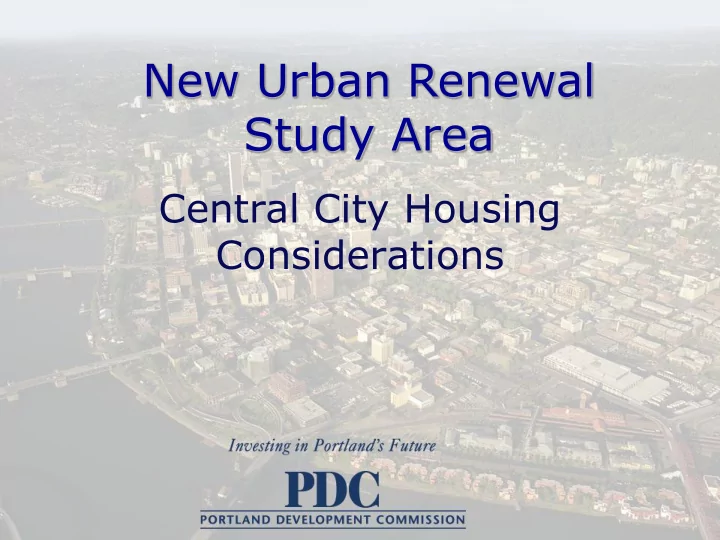

New Urban Renewal Study Area Central City Housing Considerations
Topics Central City Housing Policies Urban Renewal Area Housing Strategies Emerging Housing Trends Affordable Housing Challenges Development Opportunities Considerations
1988 Central City Plan Subtext Optional Style
1999 City Comprehensive Plan Housing Goals Goal #4 Enhance Portland’s vitality as a community at the center of the region’s housing market by providing housing of different types, tenures, density, sizes, costs, and locations that accommodate the needs, preferences, and financial capabilities of current and future households.
City Housing Polices No Net Loss Affordable Housing Preservation (2001) Ten Year Plan to End Homelessness Permanent Supportive Housing (2004) Schools/Family Housing (2006) Closing the Minority Homeownership Gap (2004) TIF Set Aside Policy – Sets minimum investment for affordable housing (2007)
Diverse Housing Options Old Town Lofts onal Neighborhoods Lovejoy Station-new market rate and affordable units Body Text Headwaters-innovation Street Car Lofts-transportation The yards – affordable rental Housing Affordable Mixed Use Preservation Marshall Wells, a historic Traditional preservation condo project Museum Place-mixed Use
URA Housing Strategies Common Themes Create a vibrant 24 hour community: - Jobs-Housing-Retail-Recreation Develop balanced communities with a diversity of people and housing options. Leverage City’s investment in infrastructure, - i.e. schools, roads, retail centers, parks. Make neighborhoods more dense to absorb population growth. Redevelop Vacant and underutilized property.
Downtown Housing Strategy South of Burnside 2001-2006 In order of priority Preserve or Replace Section 8 Housing Preserve or Replace Low-income Housing (non-section 8) Develop Mixed income and Middle-Income Rental Housing Develop Mixed and Middle Income Museum Place-mixed Use Condominiums
River District Housing Strategy North of Burnside 1999 Develop a range of housing options that reflect the income distribution of the City as a whole. Created varied options (i.e. size and tenure) for Mixed and Middle Income Condominiums and apartments. Establish Targets for housing development based on HUD Median Family Income categories. Sitka apartments-affordable to below 60% MFI Encourage Homeownership. Clean up under utilized land to encourage development.
Recent Housing Trends Lack of Capital Condo conversion cycle Foreclosures Falling wages and unemployment Demand for family housing Demand for middle income workforce housing Emerging demand for sustainability practices 20 minute neighborhoods Green Building Social Equity
Affordable Housing Preservation Preserving already affordable housing from conversion to market rate. Challenges: Expiring Federal Section 8 & Low Income Housing Tax Credit contracts Rent increases & conversion of open market/privately owned to condos/rental or student housing Constrained Federal resources Limited local resources Aging inventory that require additional investment (maintenance, repairs and ongoing operations) No identified funding source for future development
Preservation Opportunities 6 Expiring Section 8 properties – 471 units- adequate funding needs to be identified Other expiring tax credit properties may need assistance
New Urban Renewal Study Area Body Text
Redevelopment Potential
Current Housing
Development Opportunities ? Goosehollow Neighborhood characteristics, needs? South of Market PSU student housing? Connections to OHSU? Employer Supported Housing? Sustainability District? North of Market Support the retail core? Supportive Infrastructure? Northwest Proximity to single family neighborhoods? Connections to Pearl Neighborhood? Potential to master plan?
Considerations for URA Boundaries Supports City Housing Policy Redevelopment potential for housing Creates a vibrant community
Considerations for URA Boundaries Supports City Housing Policy Provides housing of different types, costs, and locations that accommodate the needs, preferences, and financial capabilities of current and future households. Affordable Housing Preservation(Section 8 and Tax Credit) No Net Loss of unrestricted affordable housing Timing of needs vs opportunities
Considerations for URA Boundaries Redevelopment potential appropriate for housing Affordable land Can be master planned Current conditions and distribution of housing Areas with potential to generate increment and support non- increment generating projects Infill redevelopment
Considerations for URA Boundaries Creates a vibrant community Supports a mix of housing, jobs, retail, recreation. Potential for mixed use/mixed income development. Has or could benefit from community amenities such as schools, parks, social services, retail. Attracts a diverse group of people by income and other measures.
Housing Opportunities Central City URA
Recommend
More recommend